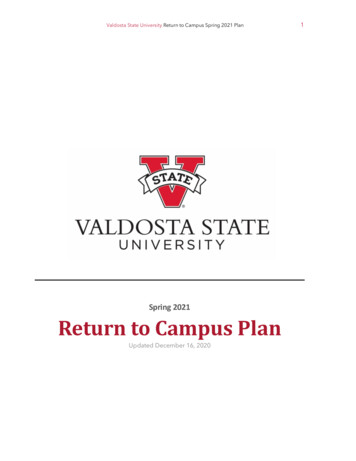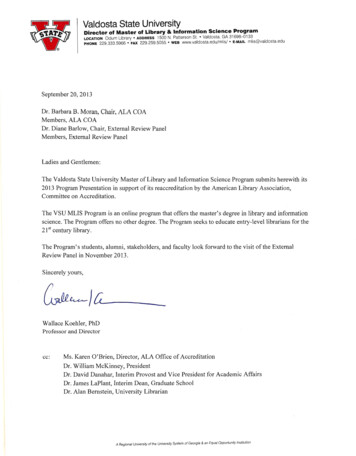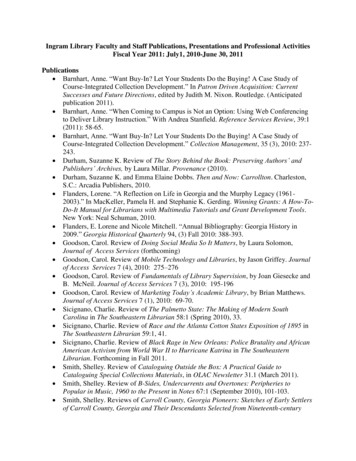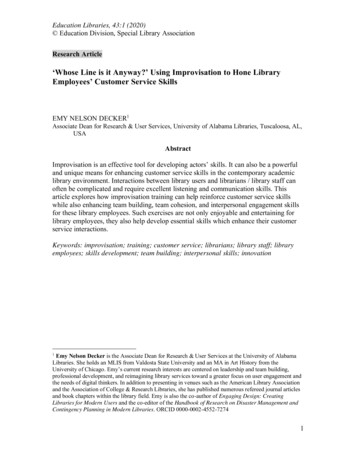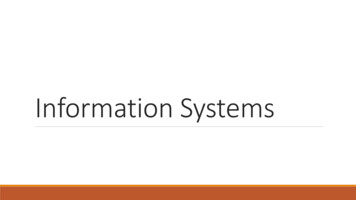
Transcription
Information Systems
Information Management in a Global Society - HackbarthInformation Technology has Flattened the WorldWe Live in a Global VillageSocial Accountability, Diversity, and InclusivityInternational Companies Operate Differently than National, State or LocalCompaniesInternational Non-Profit Organizations (NGO’s)
Information Management in a Global Society cont.Strategic Business Objectives of Global Information Systems Operational Excellence but with Cultural Differences Developing New Products, Services, and Different Business Models Reimaging or Repurposing Traditional Products and Services Customer and Supplier Familiarity and Understanding Improved Decision Making Using Analytics Competitive Advantage in the Global Context Survival
Information Management in a Global Society cont.Information ethics has been defined as "the branch of ethics that focuses on the relationshipbetween the creation, organization, dissemination, and use of information, andthe ethical standards and moral codes governing human conduct in society".The Ethical Use of Information includes the proper Quoting, Paraphrasing, and Citing ofothers work.Major issues in Information Ethics Privacy Accuracy of Data or Information (Corruptibility) Intellectual Property (Ease of Reproducing) Accessibility of information (Literacy) Reading, writing, reasoning, and calculating
Security, Privacy, and Ethical IssuesInformation Security or “infosec” or “data security” or “cybersecurity” is a set of practices intendedto keep data secure from unauthorized access or alterations.Cybersecurity is the broader practice of defending Information Technology (IT) assets from attack.Three Objectives of Information Security or (CIA) Confidentiality Integrity AvailabilityInformation Security Measures Technical Measures (Hardware and Software)Organizational Measures (Internal policies and procedures to protect information)Human Measures (Awareness Training)Physical Measures (Physical access control to facilities)
Security, Privacy, and Ethical Issues, cont.Data Privacy or Information Privacy deals with the ability of an organization or individual todetermine what data in a computer systems can be shared with third parties.Privacy risk is defined as the “potential loss of control over personal information”Data privacy creates boundaries and protects organizations and people from unwarranted interferencein our lives by negotiating relationships that avoid or prevent the arbitrary and the unjustified use ofinformation by people, companies, nation-states or other actors.Non-Personal Information is traditionally information that may not directly identify or be used tocontact a specific individual, such as an Internet Protocol (“IP”) address or mobile device uniqueidentifier, particularly if that information is de-identified (meaning it becomes anonymous).Some of the greatest risk to privacy are Trojan horses, ransomware, and other forms of malware thatcan wreak havoc with your data.
Automation and Support SystemsAutomation is the creation and application of technology to monitor and control the production and delivery of products and services. Uses automated equipment in a system of manufacturing or other production process.An automated system is composed of elements that perform a set of task that have been programmed.Benefits of automated systems Eliminates paper documents Utilizes employees time better by focusing on non-standard decision-making Identifies business processes as you automate repetitive human tasks Allows for better projections through better monitoring Identifies unused resources that Creates new business opportunities coalescing data and using in new ways Save money while sleeping Manage decentralized teams in different time zonesChallenges of automation Integration and compatibility of systems Return on Investment (ROI), some automation is costly Complexity Security
Transaction Processing SystemsA Transaction Processing System is a set of information which processes the data transaction indatabase system that monitors transaction programs. The system is useful when something is sold overthe internet. It allows for a time delay between when an item is being sold to when it is actually sold.Steps needed to process data Data capture and processingData storageData conversion to a usable formatData cleaningData ValidationData separation and sortingData Summarization and aggregationData presentation and reporting
Transaction Processing Systems, cont.Data Processing Types Scientific Data Processing Cleaning and validating steps take more time than commercial processing Sorting and summarizations ensure no selection bias or wrong relationships Commercial Data Processing Standardized data May not need complex sorting Data processed directly with largely automated error checking Automatic versus Manual Data Processing Spreadsheets may be considered manual processing Batch Processing Batch processing completes a range of data processes as a batch, by simplifying single commands to provide actions to multiple data sets Real-time Processing Data collected as it happens Online Processing Derived from automatic processing and is known as immediate or irregular access handling Multi-processing Most common techniques because of efficiency from using multiple CPU’s Time-sharing One unit of time is used by several users
Management Information SystemsManagement Information Systems (MIS) is the study of people, technology, organizations, and therelationships among them. MIS professionals help firms realize maximum benefit from investment inpersonnel, equipment, and business processes. MIS is a people-oriented field with an emphasis onservice through technology.Data is the “bridge” between Hardware and Software and Processes and People.A management information system (MIS) is a computer system consisting of hardware and softwarethat serves as the backbone of an organization’s operations. An MIS gathers data from multiple onlinesystems, analyzes the information, and reports data to aid in management decision-making.The purpose of information management is to: design, develop, manage, and use information withinsight and innovation. support decision making and create value for individuals, organizations,communities, and societies.Some of the common types of Management Information Systems include process control systems,human resource management systems, sales and marketing systems, inventory control systems, officeautomation systems, enterprise resource planning systems, accounting and finance systems andmanagement reporting systems.
Decision Support and Expert SystemsDefinition of a Decision Support System A Decision Support System (DSS) is a set of related programs and data required to assist with analysis anddecision-making within an organization. Decision support systems (DSS) are interactive software-based systems intended to help managers indecision-making by accessing large volumes of information generated from various related informationsystems involved in organizational business processes, such as office automation system, transactionprocessing system, etc. DSS uses the summary information, exceptions, patterns, and trends using the analytical models. A decisionsupport system helps in decision-making but does not necessarily give a decision itself. The decision makerscompile useful information from raw data, documents, personal knowledge, and/or business models toidentify and solve problems and make decisions. A decision support system gathers and analyzes data, synthesizing it to produce comprehensive informationreports. In this way, as an informational application, a DSS differs from an ordinary operations application,whose function is just to collect data. Examples include projected revenue, sales figures or past ones fromdifferent time periods, and other inventory- or operations-related data.
Decision Support and Expert Systems, cont.Decision support systems allow for more informed decision-making, timely problem-solving, and improved efficiency in dealing with issues or operations, planning, andeven management.Makes Two Types of Decisions Programmed Decisions Decisions that have been made several times Decisions that follow some guidelines or rules Non-Programmed Decisions Occur in unusual or non-addressed situations Is a new decision No rules to apply Decisions based on best available information Decisions based on managers discretion, instinct, perception, and judgmentBenefits Improves efficiency and the speed of decision-making activities Increases control, competitiveness, and capability to make futuristic decisions Facilitates interpersonal communication Encourages learning and training May reveal new approaches and provides evidence for unusual or no-standard decisions Automates managerial processes
Decision Support and Expert Systems, cont.Expert System (ES) A Business Expert System (BES) is a knowledge based information system, which is based on artificialintelligence. A Knowledge Based information system adds a knowledge base that uses its knowledgeabout a specific, complex application area to act as an expert. In artificial intelligence, an expert system is a computer system that emulates the decisionmaking ability of a human expert. Expert systems are designed to solve complex problems byreasoning through bodies of knowledge, represented mainly as if–then rules rather than throughconventional procedural code. (Used a lot in Healthcare by Doctors to diagnose) A DSS is an interactive system that helps decision-makers utilize data and models to solve unstructuredor semi-structured problems. An ES is a problem-solving computer program that achieves goodperformance in a specialized problem domain that is considered difficult and requires specializedknowledge and skill.
Decision Support and Expert Systems, cont.Advantages of Expert Systems Provide answers for decisions, processes and tasks that are repetitive Hold huge amounts of information Minimize employee training costs Centralize the decision making process Make things more efficient by reducing the time needed to solve problems Combine various human expert intelligences Reduce the number of human errors Provide strategic and comparative advantages that may create problems for competitors Look over transactions that human experts may not think ofDisadvantages of Expert Systems No common sense used in making decisions Lack of creative responses that human experts are capable of Not capable of explaining the logic and reasoning behind a decision It is not easy to automate complex processes There is no flexibility and ability to adapt to changing environments Not able to recognize when there is no answer
Enterprise Systems (ERP)Enterprise resource planning (ERP) is the ability to deliver an integrated suite of businessapplications. ERP tools share a common process and data model, covering broad and deep operationalend-to-end processes, such as those found in finance, HR, distribution, manufacturing, service and thesupply chain.Is a type of software that organizations use to manage day-to-day business activities such asaccounting, procurement, project management, risk management and compliance, and supply chainoperations. Has a consistent feel throughout.ERP system modules include: product lifecycle management, supply chain management(for example purchasing, manufacturing and distribution), warehouse management, customerrelationship management (CRM), sales order processing, online sales, financials, human resources,and decision support system.
Enterprise Systems (ERP), cont.Customer Resource Management (CRM) is a technology for managing all of a companiesrelationships and interactions with customers and potential customers. Is a tool that stores customer and prospective customer contactinformation, identifies sales opportunities, records service issues,manages marketing campaigns, all in one central location. Integrates and monitors sales, customer services, marketing, andsocial media into a clear overview of your customer
Business Test Contents Information SystemsA. INFORMATION SYSTEMS IN BUSINESS AND SOCIETY HWANG
Information Management in a Global SocietyInformation Technology has Flattened the WorldWe Live in a Global VillageSocial Accountability, Diversity, and InclusivityInternational Companies Operate Differently than National, State or Local CompaniesInternational Non-Profit Organizations (NGO’s)
Information Management in a Global Society- cont.Strategic Business Objectives of Global Information Systems Operational Excellence but with Cultural Differences Developing New Products, Services, and Different Business Models Reimaging or Repurposing Traditional Products and Services Customer and Supplier Familiarity and UnderstandingImproved Decision Making Using AnalyticsCompetitive Advantage in the Global ContextSurvival
Information Management in a Global Society- cont.Information ethics has been defined as "the branch of ethics that focuses on the relationshipbetween the creation, organization, dissemination, and use of information, andthe ethical standards and moral codes governing human conduct in society".The Ethical Use of Information includes the proper Quoting, Paraphrasing, and Citing of otherswork.Major issues in Information Ethics PrivacyAccuracy of Data or Information (Corruptibility)Intellectual Property (Ease of Reproducing)Accessibility of information (Literacy) Reading, writing, reasoning, and calculating
Security, Privacy, and Ethical IssuesInformation Security or “infosec” or “data security” or “cybersecurity” is a set of practices intendedto keep data secure from unauthorized access or alterations.Cybersecurity is the broader practice of defending Information Technology (IT) assets from attack.Three Objectives of Information Security or (CIA) Confidentiality Integrity AvailabilityInformation Security Measures Technical Measures (Hardware and Software)Organizational Measures (Internal policies and procedures to protect information)Human Measures (Awareness Training)Physical Measures (Physical access control to facilities)
Security, Privacy, and Ethical IssuesData Privacy or Information Privacy deals with the ability of an organization or individual todetermine what data in a computer systems can be shared with third parties.Privacy risk is defined as the “potential loss of control over personal information”Data privacy creates boundaries and protects organizations and people from unwarranted interferencein our lives by negotiating relationships that avoid or prevent the arbitrary and the unjustified use ofinformation by people, companies, nation-states or other actors.Non-Personal Information is traditionally information that may not directly identify or be used tocontact a specific individual, such as an Internet Protocol (“IP”) address or mobile device uniqueidentifier, particularly if that information is de-identified (meaning it becomes anonymous).Some of the greatest risk to privacy are Trojan horses, ransomware, and other forms of malware thatcan wreak havoc with your data.
Hardware technology Computer hardware consists of electronic devices that input, process, output, andstore data according to instructions encoded in software programs. Every computer has a central processing unit (CPU), which is also called a centralprocessor, main processor or microprocessor. The CPU contains control unit andarithmetic/logic unit. As the brain of the computer, the CPU executes instructionsthat make up software programs. The CPU works in conjunction with random access memory (RAM), which is alsocalled main memory. This is the temporary memory used to store the results ofcomputations. Storage hardware is used to save data and software programs. Hard disks (alsocalled magnetic disks) are the most common storage device. Solid-state storage(also called an SSD drive) is much faster than a hard disk and gaining inpopularity. USB flash drives are portable SSD drives.
Hardware technology – cont. The exploding power of computer hardware and networking technology has dramatically changedhow businesses organize their computing power. Here are key emerging hardware trends: Grid computing involves connecting geographically remote computers into a single network tocreate a virtual supercomputer by combining the computational power of all computers on the grid. Virtualization is the process of presenting a set of computing resources so that they can all beaccessed in ways that are not restricted by physical configuration or geographic location. Cloud computing is a model of computing in which computing processing, storage, and softwareare provided as a pool of virtualized resources, which can be accessed on an as-needed basis fromany connected device and location. Automatic computing is an industry-wide effort to develop systems that can configure themselves,heal themselves when broken, and protect themselves from intruders.
Software technology Computer software is a collection of instructions that tell the computer how to work. This is incontrast to computer hardware, from which the system is built and actually performs the work. Open source software is not restricted to any specific operating system or hardware technology.One of the most well-known open source software is Linux, an operating system related to Unix. Software as a service (SaaS) is a cloud-based service in which a vendor hosts software programsand makes them available to a client firm over the network. Pre-packaged software is a pre-written commercially available software product that eliminates theneed for a firm to build its own software. Software outsourcing enables a firm to contract custom software development to third-party ITvendors. A service-level agreement (SLA) defines the level of service a client firm expects from avendor, laying out the metrics by which service is measured, as well as penalties should agreed-onservice levels not be achieved.
Database management systems A database refers to any collection of electronic records that can be processed toproduce useful information. A Database Management System (DBMS) is software designed to store, retrieve,define, and manage data in a database. It acts as an interface between applicationprograms and the physical data files. A relational database is a collection of data items with pre-defined relationshipsbetween them. These items are organized as a set of tables with columns (fields)and rows (records). Each table in a relational database has a designated column used as a primary key,which is the unique identifier for all the information in any row of the table. A database query is a request for data from a database. A structured querylanguage (SQL) is the standard language for managing data stored in a relationalDBMS.
Database management systems – cont. A data warehouse is a database that stores current and historical data of potentialinterest to decision makers throughout the company. A data mart is a subset of a data warehouse in which a highly focused portion ofthe organization's data is placed in a separate database for a certain group. Online Analytical Processing (OLAP) performs multidimensional analysis ofbusiness data and provides the capability for complex calculations, trend analysis,and sophisticated data modeling. Unlike relational databases, OLAP tools do notstore individual transaction records in two-dimensional, row-by-column format.Instead, OLAP tools use multidimensional database structures called cubes tostore arrays of consolidated information. Data mining is a process of discovering patterns in large data sets to predictoutcomes. Businesses can learn more about their customers to develop moreeffective marketing strategies.
Network and internet technology Most networks contain a connecting point between the computers. Hubs send data packets to allother connected devices. Switches have more intelligence than hubs and can forward data to aspecified destination. While hubs and switches create a network, routers connect a network todifferent networks. Routers are responsible for finding the shortest path to the final destination fordata packets. Client/server computing is a distributed computing model in which some of the processing poweris located within small client computers. These clients are linked to one another through a networkthat is controlled by a server computer. Packet switching is a method of slicing digital messages into parcels called packets, sending thepackets along different communication paths as they become available, and then reassembling thepackets once they arrive at their destinations. A protocol is a set of rules and procedures governing data transmissions between two points in anetwork. Transmission Control Protocol/Internet Protocol (TCP/IP) is a set of protocols specifyinghow data should be packetized, addressed, transmitted, routed, and received between computers.
Network and internet technology – cont. There are different kinds of networks in terms of their geographic scope. A localarea network (LAN) connects personal computers to other digital devices within ahalf-mile radius. Wide area networks (WANs) span broad geographic distances –entire regions, states, continents, or the entire globe. Web 2.0 refers to the second generation of the World Wide Web. It is bestcharacterized by websites that emphasize user-generated content and participatoryculture (e.g., social networking sites) Bluetooth is the popular name for the 802.15 wireless networking standard, whichis useful for creating small personal area networks (PANs). The 802.11 set of standards for wireless LANs and wireless Internet access is alsoknown as Wi-Fi. Radio frequency identification (RFID) systems provide a powerful technology fortracking the movement of goods throughout the supply chain.
Automation and Support SystemsAutomation is the creation and application of technology to monitor and control the production and delivery of products and services. Uses automated equipment in a system of manufacturing or other production process.An automated system is composed of elements that perform a set of task that have been programmed.Benefits of automated systems Eliminates paper documents Utilizes employees time better by focusing on non-standard decision-making Identifies business processes as you automate repetitive human tasks Allows for better projections through better monitoring Identifies unused resources that Creates new business opportunities coalescing data and using in new ways Save money while sleeping Manage decentralized teams in different time zonesChallenges of automation Integration and compatibility of systems Return on Investment (ROI), some automation is costly Complexity Security
Transaction Processing SystemsA Transaction Processing System is a set of information which processes the data transaction indatabase system that monitors transaction programs. The system is useful when something is sold overthe internet. It allows for a time delay between when an item is being sold to when it is actually sold.Steps needed to process data Data capture and processingData storageData conversion to a usable formatData cleaningData ValidationData separation and sortingData Summarization and aggregationData presentation and reporting
Transaction Processing Systems – cont.Data Processing Types Scientific Data Processing Cleaning and validating steps take more time than commercial processing Sorting and summarizations ensure no selection bias or wrong relationships Commercial Data Processing Standardized data May not need complex sorting Data processed directly with largely automated error checking Automatic versus Manual Data Processing Spreadsheets may be considered manual processing Batch Processing Batch processing completes a range of data processes as a batch, by simplifying single commands to provide actions to multiple data sets Real-time Processing Data collected as it happens Online Processing Derived from automatic processing and is known as immediate or irregular access handling Multi-processing Most common techniques because of efficiency from using multiple CPU’s Time-sharing One unit of time is used by several users
Management Information SystemsManagement Information Systems (MIS) is the study of people, technology, organizations, and the relationshipsamong them. MIS professionals help firms realize maximum benefit from investment in personnel, equipment,and business processes. MIS is a people-oriented field with an emphasis on service through technology.Data is the “bridge” between Hardware and Software and Processes and People.A management information system (MIS) is a computer system consisting of hardware and software that servesas the backbone of an organization’s operations. An MIS gathers data from multiple online systems, analyzes theinformation, and reports data to aid in management decision-making.The purpose of information management is to: design, develop, manage, and use information with insight andinnovation. support decision making and create value for individuals, organizations, communities, and societies.Some of the common types of Management Information Systems include process control systems, humanresource management systems, sales and marketing systems, inventory control systems, office automationsystems, enterprise resource planning systems, accounting and finance systems and management reportingsystems.
Decision Support and Expert SystemsDefinition of a Decision Support System A Decision Support System (DSS) is a set of related programs and data required to assist with analysis anddecision-making within an organization. Decision support systems (DSS) are interactive software-based systems intended to help managers indecision-making by accessing large volumes of information generated from various related informationsystems involved in organizational business processes, such as office automation system, transactionprocessing system, etc. DSS uses the summary information, exceptions, patterns, and trends using the analytical models. A decisionsupport system helps in decision-making but does not necessarily give a decision itself. The decision makerscompile useful information from raw data, documents, personal knowledge, and/or business models toidentify and solve problems and make decisions. A decision support system gathers and analyzes data, synthesizing it to produce comprehensive informationreports. In this way, as an informational application, a DSS differs from an ordinary operations application,whose function is just to collect data. Examples include projected revenue, sales figures or past ones fromdifferent time periods, and other inventory- or operations-related data.
Decision Support and Expert Systems- cont.Decision support systems allow for more informed decision-making, timely problem-solving, and improved efficiency in dealing with issues or operations, planning, and evenmanagement.Makes Two Types of Decisions Programmed Decisions Decisions that have been made several times Decisions that follow some guidelines or rules Non-Programmed Decisions Occur in unusual or non-addressed situations Is a new decision No rules to apply Decisions based on best available information Decisions based on managers discretion, instinct, perception, and judgmentBenefits Improves efficiency and the speed of decision-making activities Increases control, competitiveness, and capability to make futuristic decisions Facilitates interpersonal communication Encourages learning and training May reveal new approaches and provides evidence for unusual or no-standard decisions Automates managerial processes
Decision Support and Expert Systems – cont.Expert System (ES) A Business Expert System (BES) is a knowledge based information system, which is based on artificialintelligence. A Knowledge Based information system adds a knowledge base that uses its knowledgeabout a specific, complex application area to act as an expert. In artificial intelligence, an expert system is a computer system that emulates the decisionmaking ability of a human expert. Expert systems are designed to solve complex problems byreasoning through bodies of knowledge, represented mainly as if–then rules rather than throughconventional procedural code. (Used a lot in Healthcare by Doctors to diagnose) A DSS is an interactive system that helps decision-makers utilize data and models to solve unstructuredor semi-structured problems. An ES is a problem-solving computer program that achieves goodperformance in a specialized problem domain that is considered difficult and requires specializedknowledge and skill.
Decision Support and Expert Systems- cont.Advantages of Expert Systems Provide answers for decisions, processes and tasks that are repetitive Hold huge amounts of information Minimize employee training costs Centralize the decision making process Make things more efficient by reducing the time needed to solve problems Combine various human expert intelligences Reduce the number of human errors Provide strategic and comparative advantages that may create problems for competitors Look over transactions that human experts may not think ofDisadvantages of Expert Systems No common sense used in making decisions Lack of creative responses that human experts are capable of Not capable of explaining the logic and reasoning behind a decision It is not easy to automate complex processes There is no flexibility and ability to adapt to changing environments Not able to recognize when there is no answer p
Management Information Systems Management Information Systems (MIS) is the study of people, technology, organizations, and the relationships among them. MIS professionals help firms realize maximum benefit from investment in personnel, equipment, and business processes. MIS is a people-orien
